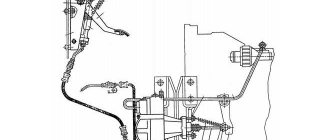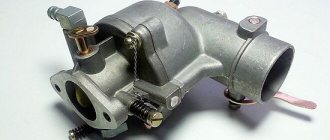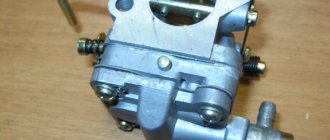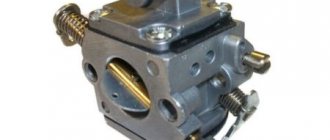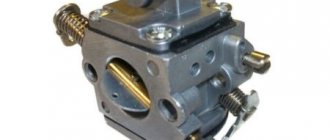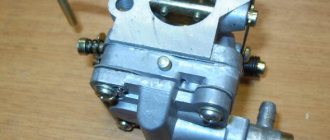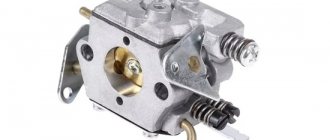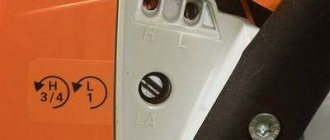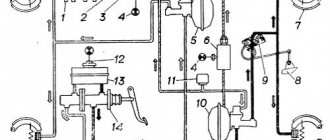The GAZ 52 carburetor is considered an obsolete unit, although to this day it is found on various trucks or forklifts, where the old-style ZMZ-53 and ZMZ-53-11 engines are installed. Examples of such vehicles include the famous GAZ 66 and PAZ buses. Since a considerable number of such cars are still in operation, questions about repairing the fuel supply system do not lose their relevance.
This is what a Gas 52 truck looks like
K126 carburetor design
Let's look at the design of the K126 carburetor. The K126N carburetor is designed similarly. The K-126 carburetor is an emulsion, two-chamber, falling flow, with sequential opening of the throttle valves and a balanced float chamber.
The carburetor has two mixing chambers: primary and secondary. The primary chamber operates in all engine modes. The secondary chamber comes into operation under heavy load (after approximately 2/3 of the throttle travel of the primary chamber).
To ensure uninterrupted operation of the engine in all modes, the carburetor has the following metering devices: a cold running system of the primary chamber, a transition system of the secondary chamber, main metering systems of the primary and secondary chambers, an economizer system, a cold engine starting system and an accelerator pump system. All elements of the dosing systems are located in the body of the float chamber, its cover and the housing of the mixing chambers. The body and cover of the float chamber are cast from zinc alloy TsAM-4-1. The housing of the mixing chambers is cast from aluminum alloy AL-9. Sealing cardboard gaskets are installed between the float chamber body, its cover and the mixing chamber body.
Advantages and disadvantages of K126G
The K126G carburetor is quite popular among UAZ owners. It is valued for a number of advantages that are missing from more modern models:
- stable operation in the presence of clogging;
- unpretentiousness to fuel quality;
- sufficient economy.
The K126G carburetor, the mixture quality of which is adjusted regularly, will work without any problems. Simplicity of design is a guarantee of reliability. In this case it will comply, but subject to scheduled maintenance.
The K126G has one unpleasant drawback. If overheated, the device body may become deformed. This occurs when the carburetor threads are over-tightened.
Adjusting the K126 carburetor
K-126 carburetors are very simple in design, moderately reliable and require minimal maintenance when used correctly. Most malfunctions occur either after unqualified intervention in the adjustments or in the event of clogging of the dosing elements with solid particles. Among the types of maintenance, the most common are flushing, adjusting the fuel level in the float chamber, checking the operation of the accelerator pump, adjusting the starting system and idle system.
Let's look at adjusting the carburetor to 126 using the example of K 126GU.
Adjusting the fuel level of the carburetor K126
Adjusting the fuel level K126
Check the fuel level with the car engine not running and installed on a horizontal platform. When pumping fuel using a manual pump drive, the fuel level in the carburetor float chamber must be established within the limits marked by the marks (tides) “a” on the walls of the inspection window. If the level deviates from the specified limits, make an adjustment by removing the float chamber cover. Adjust the level by bending tongue 3 (see figure). At the same time, by bending limiter 2, set the needle stroke 5 of the fuel supply valve to 1.2 - 1.5 mm. After adjustment, check the fuel level again and, if necessary, adjust again. Considering that during operation, due to wear of the float mechanism, the fuel level gradually increases, set it when adjusting to the lower limit. In this case, the fuel level will remain within acceptable limits for a longer period of time.
Note. When adjusting the fuel level in the carburetor float chamber, do not bend the float tongue by pressing the float, but bend it using a screwdriver or pliers.
Adjusting the idle speed of the K126 carburetor
Adjustment of the minimum idle speed of the crankshaft is carried out in the following sequence:
- warm up the engine to operating temperature;
- screw screw 15 all the way, but not tightly, and then unscrew it 1.5 turns;
— start the engine and use the throttle valve thrust screw 43 to set a stable crankshaft speed of 550 - 650 rpm;
The adjustment results are checked by sharply pressing the gas pedal, the engine should not stall, there is a smooth drop in speed
Screw 15 of the toxicity limiter adjusts the limit value of carbon monoxide (if a gas analyzer is available).
You can adjust the idle system of the K126 carburetor without a gas analyzer.
This is how this procedure is described in the book by N.N. Tikhomirov. “Carburetors K-126, K-135”:
In the absence of a gas analyzer, you can achieve almost the same accuracy of regulation using only a tachometer or even by ear. To do this, on a warm engine and with the position of the “quantity” screw unchanged, find, as described above, the position of the “quality” screws that ensures the maximum engine speed. Now use the “quantity” screw to set the rotation speed to approximately 650 min.”1. Check with the “quality” screws whether this frequency is the maximum for the new position of the “quantity” screw. If not, repeat the entire cycle again to achieve the required ratio: the quality of the mixture ensures the highest possible speed, and the number of revolutions is approximately 650 min."1. Remember that the “quality” screws must be rotated synchronously.
After this, without touching the “quantity” screw, tighten the “quality” screws enough so that the rotation speed decreases by 50 min”1, i.e. up to the regulated value. In most cases, this adjustment meets all GOST requirements. Adjustment in this way is convenient in that it does not require special equipment, and can be carried out every time the need arises, including for diagnosing the current state of the power system.
ZIL Housekeeping Assistant › Logbook › Adjusting and tuning the caburator (carb gas 53).
Hi all! I have such a Gazonovsky carb, visually in the photo, I don’t know the number on the carb itself, level 2 inscriptions, and on the back it was made in Russia. Here’s a problem that seems like a small thing, but at the same time it’s not a small thing. I assembled the motor and now it’s time to tune the motor. I checked the spark plugs, the distributor cap and new wires, the ignition is set. At idle it seems to work cleanly, but you press the gas pedal and it either stalls or revs up a couple of times, it de-accelerates, it doesn’t develop maximum speed, it can’t start normally, the car doesn’t drive, in general it’s a nightmare, I cleaned the carb, you could say by slightly partial disassembling, that is, I removed the top cover, the level is normal , I blew out the jets, it seems to be sulking everywhere. Although before the repair there was no sneezing or coughing, it seemed to be moving normally. Gasoline seems to be normal from GAZPROM. In general, help, tell us what to clean in it, what else can be turned and where not to go. P.S. The issue with the carburetor was resolved, cured by complete disassembly, cleaning with a van + compressor and tuning according to the manual.
Unit design
Together with six-cylinder gasoline engines ZMZ-53, carburetors of the K-126 series with different letter indices are used. On cars with the updated ZMZ-53-11 engine, they began to install another version of carburetors - K-135.
Their design is almost identical to the predecessors of the K-126, with the exception of a few additions, so the design and operation of the unit should be considered using the example of the 126 series.
The manufacturer of the famous K-126 and K-135 series is the Petersburg Carburetors enterprise, abbreviated as PeKar. One important feature: the products have a two-chamber device, but the cameras do not distinguish between primary and secondary, since they work synchronously.
Disassembled carburetor of a Gas 52 car
Like any unit designed to meter fuel using vacuum from the engine, the 126 series has the following main systems:
- main dosing;
- idle channels;
- ensuring a smooth transition to different operating modes;
- accelerator pump;
- forced enrichment of the mixture, implemented using an econostat;
- cold engine start;
- crankshaft speed limiter.
To understand the principle of operation of the GAZ 52 carburetor, it is worth considering the operation of all of the listed systems.
Applicability of K126G
A carburetor marked “K126G” was installed and is still serviced on Gaz-24 “Volga” and UAZ vehicles, with mainly UMZ-417 engines. UAZ car owners especially love this model for its unpretentiousness and ability to work even with clogged fuel.
With minor modifications (drilling a hole), the K126G is installed on UMZ-421 engines. And this could be either a UAZ or a Gazelle. The predecessor of the K126G can be considered the K151, and the next model is the K126GM.
Adjusting the K126G carburetor is the most popular question among carburetor technicians. But first, let's look at various problems that can happen with the K126G.
Operating principle of K-126 systems
The main metering system is designed to mix fuel with air in certain proportions and supply it to the engine intake manifold in driving mode (main load). There are 2 such systems in K-126 carburetors and they are absolutely identical. Both are fed with fuel from a common float chamber, where the gasoline level is maintained by a pressure needle valve. Dosing is carried out according to the principle of carburetion, that is, the suction of the air-fuel mixture into the cylinders due to vacuum.
The system operation algorithm is as follows:
- Gasoline, passing through the calibrated holes of the main fuel jets, enters the mixing chamber.
- Filtered air passes through the main air jet also enters there.
Scheme of operation of the K-126 carburetor
In parallel with the main metering system, there is an idle system, of which there are also 2. The principle of operation is the same, only the air-fuel mixture is drawn in in small quantities through a network of channels where small idle jets are built-in. The first channel outlet in the form of a slot is located in the diffuser wall under the throttle valve, the second is in the gasoline chamber. Thanks to this, the operation of the system does not depend on the position of the damper, since fuel is sucked in through the gap under it.
This is how the car engine runs at idle, although the system continues to operate under load. To enrich or lean the mixture, an adjusting screw is installed in the channel. The second screw, which regulates the amount of fuel, mechanically opens the damper, thereby increasing the flow area of the gap.
To ensure a smooth transition from idle to main mode and back, several holes in the transition system are made in the walls above the dampers. The more the throttle opens, the stronger the vacuum becomes, drawing fuel through these holes and preventing the engine from stalling. When you sharply press the accelerator, the accelerator pump comes into action, supplying a stream of pure gasoline directly to the manifold so that “dips” do not occur. So that at certain moments the engine can develop full power, an econostat is used to assist the main dosage system in the carburetor.
Its valve operates at loads close to maximum and directs an additional amount of combustible mixture into the cylinders through a separate hole.
The task of starting a cold engine is solved by a corresponding system (in jargon - a choke), which at this moment cuts off the air supply. The air-fuel mixture is enriched to the maximum, and the engine starts, after which the air flow path is automatically opened slightly so that the engine does not stall from excessive enrichment. The system is activated manually by the driver.
Engine for truck Gas 52
Possible faults
For the most part, carburetors of the K-126 and K-135 series have served their service life, so sometimes it is easier to buy and install a new unit than to try to bring the old one to life. You can also purchase carburetors that have been used, but are still in fairly good condition.
The price of a new carburetor ranges from 4500-5000 rubles, a used unit will cost 30-60% less, depending on the degree of wear.
The main malfunction inherent in carburetors of any model is an overdose of gasoline, which causes fuel consumption to sharply increase. Problems may be accompanied by unstable operation under load and at idle, sudden failures and “triple” of the engine. There are many reasons for this, but most often the following troubles happen:
- The needle valve has lost its tightness or the float is filled with gasoline.
Then the fuel level in the compartment will be too high, causing it to flow into the manifold spontaneously. - The appearance of “dips” is associated with a breakdown of the accelerator pump or clogging of the vias. In the pump, the membrane that supplies fuel to the atomizer usually wears out.
- Clogged air channels and jets lead to excessive enrichment of the combustible mixture.
- The throttle valves were worn out at the edges and no longer covered the opening. Due to the vacuum, the engine begins to draw fuel directly through these gaps.
- The same thing happens when there is play on the throttle valve axis.
